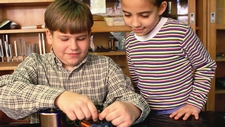Experimental Design

TEKS Objective
The student is expected to plan and implement descriptive investigations, including asking well-defined questions, making inferences, and selecting and using appropriate equipment or technology to answer his/her questions.
Essential Understanding
The student uses scientific inquiry methods during laboratory and outdoor investigations.
Science Background
The Scientific Method: Visionlearning (website) - Background information about the scientific method, with supporting learning modules that include interactive animations, glossary definitions, current news and research written by professional educators and scientists.
The Scientific Method
Visionlearning, http://www.visionlearning.com
Research Methods, Experimentation: Visionlearning (website) - Detailed information on the history and applications of experimental methods, along with references for further reading and additional learning modules on research methods.
Research Methods, Experimentation
Visionlearning, http://www.visionlearning.com
What is Inquiry Science Teaching? BioEd Online (video) - Strategies for using questions and investigations to guide your students’ science learning.
What is Inquiry Science Teaching?
BioEd Online, www.bioedonline.org
Signature Lesson
Swinging Yo-Yo: How To Smile (website) - Students build a pendulum from a yo-yo, and then design and implement their own investigations, including well-defined questions, to determine how different variables affect the pendulum's period of swing.
- Supporting Lessons
- Extensions
- Assessment Ideas
- Literature Connections
- Related
TEKS - Additional Resources
Supporting Lessons
Rockets Away: 4HCCS (PDF) - Students use straws to build rockets and then test different design variables to determine which model rocket flies the farthest.
Elaboration Lessons and Extensions
Energy Fair Experimental Design: NEED Project (PDF) - Downloadable guide to teaching students the scientific method using the experimental design model, with an emphasis on projects related to energy.
Energy Fair Experimental Design
NEED Project, http://www.need.org
Assessment Ideas
Rubric for Experimental Design: Beacon Learning Center (PDF) - Students can use this rubric to self-assess their projects/experiments, or teachers can use it summatively.
Rubric for Experimental Design
Beacon Learning Center, http://www.beaconlearningcenter.com
Literature Connections
How to Build a Better Mousetrap Car and Other Experimental Science Fun. Renner, A. (ISBN-13: 978-0396074199)
What’s the Plan? Designing Your Experiment. Hyde, Natalie (ISBN-13: 978-0778751540)
Solving Science Questions: A Book About the Scientific Process. Chappell, R.M. (ISBN-13: 978-1600445422)
Prize-Winning Science Fair Projects for Curious Kids. Rhatigan, J. (ISBN-13: 978-1579907501)
Additional Resources
Joseph Palmer's Paper Airplanes: JosephPalmer.com (website) - Teach experimental design with four paper airplane models that require no cutting, no weights, and are made from a single sheet of ordinary copier paper.
Joseph Palmer's Paper Airplanes
JosephPalmer.com, http://www.josephpalmer.com
Science Fair Central: Discovery Education (website) - Need help getting started with an independent science experiment? This site provides an abundance of ideas and suggestions.
Science Fair Central
Discovery Education, http://school.discoveryeducation.com
TEKS Navigation
Grade 4
Need Assistance?
If you need help or have a question please use the links below to help resolve your problem.

Comments